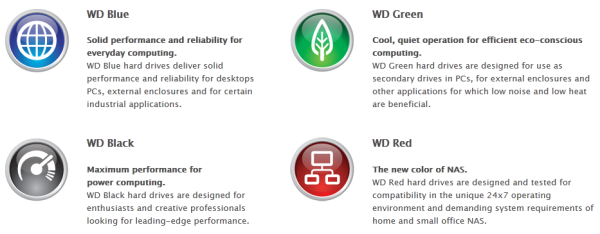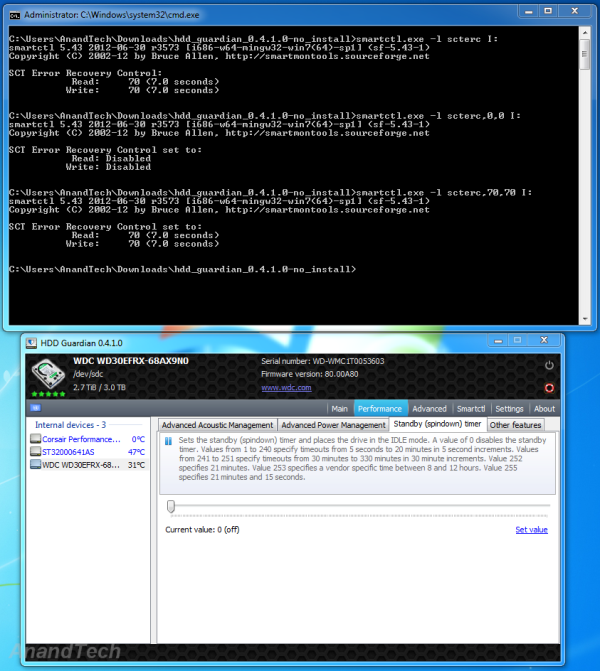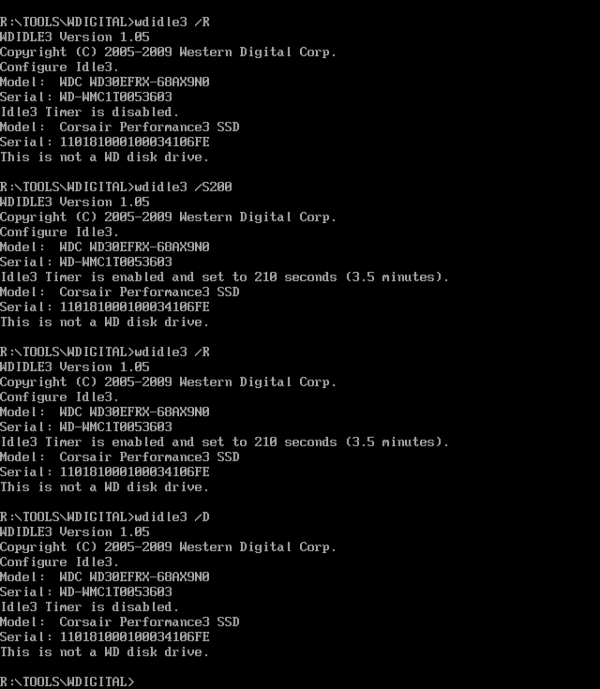Western Digital Red Review: Are NAS-optimized HDDs Worth the Premium?
by Ganesh T S on August 17, 2012 4:20 PM EST- Posted in
- Storage
- NAS
- Western Digital
WD Red Lineup: Differentiating Features
Western Digital has well-defined product categories for each market segment. The WD Black series caters to those requiring a lot of performance without power concerns. The Green series serves the opposite end of the spectrum, where performance is not that much of an issue (secondary drives for PCs / external enclosures), but heat and power could do with some reduction. The Blue series served the middle tier (everyday computing with optimal performance) and the notebook market. However, none of these models are recommended by WD for 24x7 operation (which happens to be an essential requirement for almost all NAS systems). Till now, none of the HDD vendors have anything specific for SMB / SOHO NAS systems. WD aims to capture this segment of the market with the WD Red lineup.
High end enterprise configurations are served by drives rated for stressful conditions (such as Seagate's Constellation and Cheetah lineups, WD's own RE4 and Hitachi's Ultrastar series). These drives commanded a huge price premium that even tempted some IT staff to fill their RAID arrays with consumer hard drives. Unfortunately, most of these temptations have resulted in bad results (particularly if the consumer hard drives have not been properly 'configured' prior to usage). What are the aspects which differentiate these enterprise drives from consumer versions?
SMART Command Transport Error Recovery Control: This feature allows the OS to set a soft time limit for completion of reads and writes. Seagate calls this ERC (Error Recovery Control). Samsung / Hitachi drives term this CCTL (Command Completion Time Limit), while Western Digital gives it the TLER (Time Limited Error Recovery) moniker. In a typical desktop drive, this could be a large number. In case of a bad sector or some other similar issue, the hard disk might keep retrying the access or try to remap the bad sector right away. The OS would remain waiting for the hard disk to deliver its delayed response. In a NAS environment, this delay could prove fatal, with the drive either being dropped or the NAS going into rebuild mode. So, it is essential that the SCT ERC number be set to a duration shorter than what the NAS OS would wait for before declaring the drive dead. Enterprise drives usually allow configuration of this value and set it by default to a low one (because the RAID controller can get hold of or recover the data from the other drives in the NAS).
Vibration Tolerance: NAS systems usually place a large number of drives close together. If vibrations aren't mitigated, it could result in decreased lifespan of the drives. Enterprise drives usually have increased vibration tolerance and also have in-built mechanisms to dampen themselves.
Higher MTBF and Longer Warranties: HDD vendors provide higher Mean Time Between Failures (MTBF) ratings for their enterprise drives and also walk the talk by usually providing longer warranties compared to the desktop drives.
If you are interested in further coverage of these aspects, this page serves as a good starting point. Some studies have shown that there is not much difference between desktop and enterprise hard drives with respect to real-life MTBFs. StorageMojo, in particular, has a number of posts stressing this viewpoint. Assuming that the end user has the data backed up, it is undeniable that the longer warranty period (in which RMA can be processed) is definitely an advantage. It is also likely that if the HDD vendor has enough faith to increase the warranty period, at least some improvements (particularly in the vibration tolerance mechanism) have been done compared to the consumer desktop versions.
Coming back to the WD Red, readers must be wondering how many of the above aspects can be brought to the consumers by WD without eating into their profit margins from the RE4 sales. We first start off with a overview of some of the aspects of the NASware firmware
Intelligent Error Recovery Control: This NASware feature corresponds to the TLER configuration. The value for the soft time limit can be set through smartctl, if the manufacturer allows it. We tried this out on the WD Red drive connected directly to our testbed.
We find that, by default, the soft limit is set to 7s. This means that all the NAS units certified to be compatible with the WD Red drives wait for more than 7s for a transaction to complete before dropping drives or starting a rebuild. The important aspect is that this value is configurable, and can even be completely disabled, as shown in the screenshot above.
Power Management Features: Some hard drives adopt aggressive head parking and disk spindown to save on power. For example, the WD Green drives were guilty of parking the head after just 8 seconds of inactivity. This increases the load cycle count unnecessarily (drives are usually rated for 300K cycles). Disk spindown (or standby) timer is an orthogonal parameter which actually stops the motor and puts the drive in IDLE mode. As the screenshot above shows, the standby timer is off by default, but this value can be altered through HDD Guardian or any other similar software. The head parking parameter is usually accessible through the Advanced Power Management (APM) feature of the hard drive. Unfortunately, HDD Guardian and other HDD tools indicated that there was no APM support in the WD Red. Eventually, we had to resort to running WD's own WDIDLE3 tool in the DOS mode. It turns out that the head parking interval is only accessible through a proprietary command and WD doesn't expose it to external tools.
As the screenshot above shows, head parking is completely disabled by default. It is also possible to set the head parking time limit, and it is sticky through power cycles. For NAS applications, it is better to leave it in the default state of head parking being disabled.
How does the WD Red achieve power optimization? The secret lies in IntelliPower. The WD Red drives spin at 5400 rpm as per the analysis done by the folks at SPCR. It is the combination of these features which allow the WD Reds to balance performance and also reduce power.
3D Active Balance : Vibration Reduction: WD claims that it is the first-to-market with 3D mechanical balancing technology for vibration reduction. This has obvious benefits in terms of decreasing noise and avoiding performance reduction. However, comparative measurements of this feature with the competition is outside the scope of this review.
Some of the other features of the WD Red drives include support for the ATA Streaming Command Set in the firmware. This allows optimal drive buffer management so as to ensure smooth streaming of AV data (particularly when the NAS is acting as a DLNA server). This obviously requires support in the NAS firmware also. In addition, we also have support for the SMART Command Set (SCT). We saw this earlier in this section when using smartctl to get / set the TLER parameters. Note that the SCT doesn't allow altering of the APM parameters for spindown / head parking, as they belong to the non-SMART device settings.













87 Comments
View All Comments
MrSpadge - Saturday, August 18, 2012 - link
Simple: use the right tool for the job.kmmatney - Thursday, August 23, 2012 - link
I work for a small company and we use consumer-class hardware fairly often for non-essential tasks. You have to, when working on a project with a limited budget.hsew - Friday, August 17, 2012 - link
I remember reading somewhere that Intellipower was unsuitable for RAID due to the fact that it is not a set spindle speed, rather a sweet spot speed determined in manufacturing. If it is in fact true that Intellipower is unsuitable for RAID, that would make these far less appealing as NAS drives. If I wanted to have a NAS I would want at least two drives in RAID 1. Why is WD shying away from 5400 RPM? It HAS a place, low power data storage!jwilliams4200 - Friday, August 17, 2012 - link
Why don't you read the article before you comment?hsew - Friday, August 17, 2012 - link
Because Ctrl+f didn't lead to any specific discussion on aforementioned issue...ganeshts - Friday, August 17, 2012 - link
Well, that is marketing for you :) 'People don't like lower numbers, so let us just give it a name' must have been what the WD Marketing team must have thought.FWIW, all concrete proofs of the spindle speed that I have seen online point to 5400 rpm for IntelliPower drives.
Wwhat - Sunday, August 19, 2012 - link
I think you are wrong actually, WD has drives that they use the number 5400 for, it's no real issue these days because with high density 5400 is fast enough.And I think they actually have changeable speed drives that probably max at 5400 but also ones that max at 7200 because they have a 'green' type and non-green types with the variable speed technology, so I'm prretty sure it's not some euphemism. And I also think people are more positive to numbers when it comes to HD's rather than the unspecified 'variable', it's more a risky move for WD I would say.
EnzoFX - Friday, August 17, 2012 - link
Is it me or was there no prices listed? or maybe a comparison for someone debating between reds and greens =P.ganeshts - Friday, August 17, 2012 - link
Prices are all over the park. IIRC, the 3TB version launched at $189 [ http://www.anandtech.com/show/6083/wd-introduces-r... ], but it is at $240 on Newegg right now.. I guess I left it to the reader to do the price comparison at the time of purchase :) But, thanks for mentioning.. it really was an oversight :)adrianblack - Friday, August 17, 2012 - link
I must point out the WD AV-GP line which has been out for a while were designed for 24/7 continuous and high-temp operation. I have two of these drives in my server now..... (The older 1.5TB drive has been in there for 2.5 years)WD says:
"24x7 reliability: These drives are designed to last in high temperature always-on streaming digital audio/video environments such as PVR/DVR, IPTV, and video surveillance systems."
The downside of the AV-GP line was they didn't have the idle-parking disabled, so you did have to use WDIDLE first to fix that problem. (I accumulated 245k cycles on my older 1.5TB drive before I disabled auto-park.) They have 1 million hour MTBF, some kind of optimization for better video streaming and PWL which they call preemptive wear leveling.
So pretty similar to the RED which add the vibration mitigation and a default disable on the IDLE-Park. (WD states 1 million hour MTBF on the RED drives, by the way.)